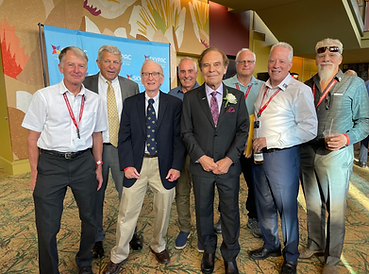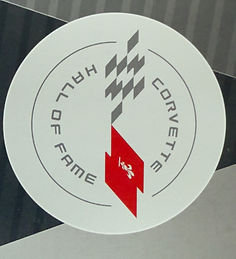

Kim R. Baker
2025 NCM Hall of Fame
and Newest Member of the
Corvette Club of Western Mass
Kim Baker’s career racing Corvettes can best be summed up in one word: Dominance. During the 1980s, when a network of privateer racers led Corvette’s motorsports efforts, Baker assembled a team that dominated the Sports Car Club of America’s (SCCA) endurance racing division. Baker’s operation, Bakeracing, was one of the best Corvette teams in the business. He and his fellow Corvette racers so thoroughly crushed their competition that for 1988 the SCCA no longer allowed the Corvette to race in the World Challenge Endurance Series, and the Corvette Challenge Spec Series was formed for 1988 and 1989.
Following two years working with the Corvette Challenge Spec Series, Baker turned his attention to the development and testing of the ZR-1, pushing the “King of the Hill” Corvette to its limits. While he later ventured into other types of motorsports, Baker’s deeds in speed made him synonymous with boosting the performance reputation of the C4 Corvette.
Baker grew up in Western Massachusetts and got his start in motorsports at a young age. He took after his father, who was a service manager at a new car dealer and did a bit of racing in the 1960s. Kim began by racing quarter midgets and karts as a boy. Once he turned 16 and earned his driver’s license, he achieved success quickly, winning the national SCCA autocross championship in 1976 in the A-Modified Unlimited category driving a Super Vee. Baker piloted various cars over the next few years as he competed in SCCA road racing in the Northeast. He would typically purchase a car, race it once or twice, then sell it in order to buy a different one.
Then came 1984, which proved to be a major turning point for Baker. It was the year that Chevrolet released the fourth-generation Corvette, which featured improved agility and handling compared to its predecessors. Although General Motors was not directly backing any Corvette racing efforts, the company was interested in collaborating with the privateer racers by offering some technical support and collecting feedback on the competitiveness of the C4. It was during this time of renewed interest in racing that Baker bought a new C4 to take to the track. During the 1984 racing season, Baker drove his Corvette in the SCCA’s showroom stock division. Showroom stock racing required and allowed few modifications for race cars. The rules were intended to have competitors race GT cars like the ones they could drive on the street. Both the C4 and Baker were natural fits, and he won every race entered, including the 1984 SCCA national championship Run-Offs at Road Atlanta driving his Corvette.
For 1985, the SCCA added a new twist to production car racing. The sanctioning body combined six endurance races into a professional championship series for which the drivers and teams could compete. Baker assembled a new team of drivers and crew members, known as Bakeracing, to focus on the endurance events. This approach worked well during the 1985 season and Baker won the final two races of the 1985 endurance series. Each victory earned Bakeracing $50,000 in bonus money from Goodyear, and the company soon became a sponsor of the team. Baker and Team performed tire testing for Goodyear before each event. Baker’s victories also caught the attention of Corvette chief engineer Dave McLellan, who offered his team a role in Corvette durability testing. According to Baker, 24 hours of racetrack testing roughly equates to 100,000 miles of street driving for most parts of the car, making track testing
much faster and more economical. Baker’s attention to detail and meticulous analysis made him well-suited for the role.
Corvettes dominated the SCCA Pro Endurance Series for the next two years, winning every race, with Bakeracing leading the way. Baker and his team won the championship and four of the six events in 1986, including 24-hour races at Mosport and Mid-Ohio. For their efforts, Goodyear awarded the team a new 1987 Corvette for the next season. GM made good use of the series and was authorized by SCCA to test prototype components in the engine and braking system. Painted yellow and black the # 4, the Corvette would become the team’s most successful car.
Bakeracing was even better in 1987, earning five victories in seven races and capturing another championship. The last win came at Sebring in dramatic fashion when the No. 4 was passed by another Corvette on what was seemingly the last lap. However, the new leading Corvette crossed the finish line three seconds short of the event’s allotted six hours, meaning that the car had to run one more lap. On that final circuit, the second-place car ran out of fuel, allowing Bakeracing to secure another win and the championship. With the season wrapped up, the team decided to retire the No. 4 Corvette, and it was sold to a collector.
Baker recalls his championship years fondly. In a 2009 interview, he noted how those seasons featured the greatest battles between the automobile and tire manufacturers of any racing series. In addition to the Team and Drivers’ Championships, Bakeracing also earned the manufacturer’s title for Chevrolet and the tire manufacturer’s championship for Goodyear. During those two seasons, Corvettes won every race with Bakeracing winning nine of the 13 events for Corvette.
After winning the 1987 Championship, Baker was contacted by the Porsche Factory Racing Chief and was offered the position of official Porsche sponsored factory team. Baker declined, citing his love of Corvettes and his loyalty to GM, Corvette and the engineers who he had befriended.
Because of the Corvette’s dominance, for the 1988 racing season, the SCCA moved the Corvettes to a new series, the Corvette Challenge Series, where slightly modified Corvettes competed against each other. Baker was “politely” asked by the organizers to not compete in the new series. Instead, Kim was offered an opportunity to do the development testing, and to assist all the teams with the proper setup for each track.
Baker also developed an interest in attempting to set new automobile speed records. One of his record-run projects in the late 1980s was a collaboration with Zora Arkus-Duntov. By this time, Zora had retired as the chief engineer of Corvette, but he still did consulting work for automobile companies and maintained his passion for tinkering with cars.
When Yugo approached Zora about enhancing the brand’s performance image, he proposed that the company attempt to break a series of speed and endurance records. He hatched a plan with Yugo America executive Tony Ciminera to prepare two Yugo’s for a 24-hour endurance run at Talladega Superspeedway. Ciminera was a former Fiat executive who had met Baker during his early SCCA career when he raced a Fiat X1/9. Because the Yugo and the Bertone X1/9 had both been developed from earlier Fiat automobiles, Ciminera recruited Baker for the planned record run.
To prepare for the record attempt, Baker made a series of modifications to the Yugos to improve their durability. These included strengthening the transaxles, utilizing lighter brake components, and modifying both cars to improve airflow. He also replaced the Yugo’s’ intake system with Weber carburetors and installed a roll cage in both cars. Unfortunately, Baker’s hard work went for naught. A war was raging in Yugoslavia and the Yugo factory was bombed. This resulted in Yugo America canceling the run at Talladega the day before it was scheduled, denying Zora and Baker a shot at the record book.
While Baker was working with Yugo, he was also involved with the development of the Corvette ZR-1. Envisioned as the first Corvette supercar, the ZR-1 was the most powerful production Corvette ever created when it debuted for the 1990 model year. Its engine was a newly designed dual-overhead-cam V8 called the LT5, which produced 375 horsepower. Through his test driver role, Baker was among the Corvette specialists who assisted with the performance testing of the ZR-1.
It was not long before Baker had an opportunity to help with another record run. In 1989, some of Baker’s compatriots in the Corvette racing world were planning a 24-hour endurance record attempt with the ZR-1. The 160.8 mph record they were chasing had stood for nearly 50 years, but GM engineer and racer Jim Minneker believed that the ZR-1 was up to the task. As Minneker conducted endurance testing for the ZR-1, Corvette racer Tommy Morrison worked to secure sponsorship and assemble a team of drivers. Along with Morrison and Minneker, the driver roster included Stu Hayner, John Heinricy, Scott Lagasse, , Scott Allman, and Baker.
The Corvette team selected Firestone’s test track in Fort Stockton, Texas, as the site of their record attempt on March 1, 1990. They would use two Corvettes, a ZR-1 and an L98. Although both Corvettes performed well in the early hours of the attempt, the team battled cold and rainy conditions throughout the day. The L98 pulled off the track after six hours, having set new short-run speed records, while the ZR-1 continued running through the night. Hour after hour, the ZR-1 and its crew held up. By the following morning, just before 10 AM, the team had accomplished their goal of setting a new 24-hour average speed record of 175.888 mph. They even decided to run an additional four hours and 46 minutes to break the 5,000-mile average speed record, which the ZR-1 also conquered.
Baker would spend the next few years keeping the C4 competitive. Corvettes were re-admitted to the SCCA’s endurance division beginning in 1990, and Bakeracing picked up right where it left off. The team won another championship in 1991 and finished second the following season. In 1994, Baker modified a ZR-1 to compete in an open road race in Nevada. His goal for this event was to surpass 200 mph during the run, and he and his team left no stone unturned to get the ZR-1 ready to race. Over the 90-mile course, Baker averaged 181 mph, crossing the finish line at 201 mph to win the event. He would enter several other open road races in the following years, winning another two.
In 1997, Baker’s wife, Patricia, encouraged Kim to acquire a Chevrolet Monte Carlo stock car and take his racing skills to NASCAR. He had previously made a handful of starts in the NASCAR Busch North Series in 1994 and 1995, driving a Pontiac. Baker ran a total of six races with the Monte Carlo, mostly on road courses from 1997 to 1999. His best results were two second place finishes in 1997 and a win at Watkins Glen in 1998.
Although Baker’s driving career was winding down by 2000, he never strayed too far from the track. He formed vintageracecarsales.com, a dealership of classic racing and sports cars, driving occasionally in vintage races. Baker and his wife also started a consulting firm to guide companies such as Panasonic, in developing motorsports marketing programs. Yet in the world of Corvette racing, Baker’s greatest legacy remains the success of Bakeracing and his triumphs in the C4. Baker’s love of motorsports and expertise on the fourth-generation Corvette made him a tough competitor, one who dominated the competition time after time.

The National Corvette Museum Spire Enclave

More about Kim R. Baker





